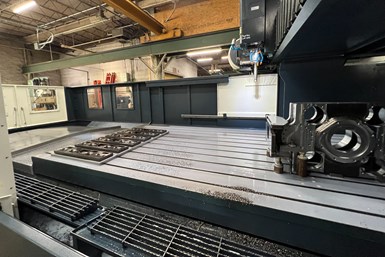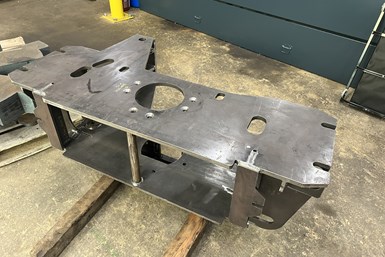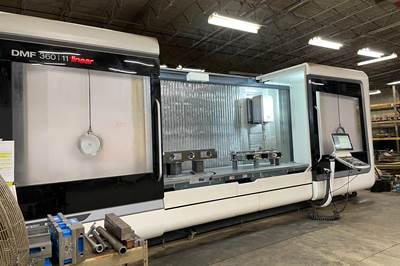Share





Two years after Barbco bought a five-axis mill to machine its monolithic parts from a single block, its machine shop has changed directions. The company, founded in 1989 and located in Canton, Ohio, is well known in the underground construction industry as a producer of trenchless boring equipment meant to drill through earth and rock without disturbing the ground above. This equipment encompasses drill heads (which can have diameters anywhere from 24 inches to 72 inches) and other components for heavy duty underground drilling machines, as well as track rails for these machines. After experimenting with five-axis milling in hopes of reducing setup times, the company’s star machine is now a double-column Johnford DMC-4100PH three-axis mill — a move that returned many of its one-piece constructions to weldments and prompted operators to learn G-code after a lifetime of using conversational programming.
Despite these seemingly counterintuitive changes, Barbco Production Manager Matthew Wolf and Lead Programmer and Foreman Andrew Liston say that production is not only back on track but running smoother than ever. “There is life after five axis,” Wolf says with a grin. By focusing on the industry it serves and being adaptable to change, rigidity and dependability now rule the day on Barbco’s shop floor.

Barbco’s Johnford DMC-4100PH is not the largest machine in Johnford’s catalog — but it was the largest that could fit in Barbco’s facility. The table can hold extremely heavy parts, supporting a total weight just over 11 tons.
Towards an Unshakable Construction
The key selling point for this bridge mill was its rigidity and stability. Barbco needed a machine that could perform both heavy-duty roughing and fine-tolerance work down to 0.0005 inch in A36 steel. When the shop’s aggressive cuts damaged the five-axis machine’s pivoting spindle head, repairs caused a delay that Barbco could not afford to repeat. With this lesson in mind, Liston and Wolf began weighing the tradeoffs between reduced setup times offered by five axis machining, versus the stability of a more rigid but less complex machine tool.
Nearby distributor Absolute Machine Tools soon introduced them to the Johnford bridge mill. While it lacks the positional five-axis capabilities of Barbco’s previous machine, its table is larger and its work travels longer, with 161 inches of X-axis travel and 90 inches of Y-axis travel. It can also hold heavier parts, and the machine’s construction is more rigid to sustain the shop’s aggressive machining strategy. The five-axis machine’s advantages in setup time and operational consolidation were greatly appreciated, and Wolf says the five-axis machine would be well suited for aerospace work, but the Johnsford bridge mill’s strengths “fit our industry better.”
For a non-rigidity example, because Barbco is an OEM for a high-wear industry and often performs field maintenance, it must deliver repair parts on tight schedules. Yet with half-day setup times for larger metal weldments used in drills and track rails, unloading parts to meet a rush order is not an option. This is when the larger size of the Johnford table comes in handy, as Barbco can set up the repair parts on a different segment of the table and add G stops to the part program to ensure the machine only works in that area.

The table on the Johnford is large enough for Barbco to set up different projects on different portions of the table, using G stops to indicate which section of the table the machine should work on at a particular time. This lets the company keep parts set up if it needs to change focus for a rush order, or if one project runs into problems that can’t immediately be resolved.
Strong Support
Meeting these rush orders also requires swift support. When Liston and Wolf talked to Absolute Machine Tools, the representative from the distributor promised prompt service that would respond to any issues in two days or less. So far, Absolute has remained true to its estimates. Wolf even says that Absolute has managed to provide same-day service on occasion, despite a 90-minute drive from the distributor’s location in Lorain, Ohio, to Barbco’s location in East Canton, Ohio. The distributor also worked to get ahead of any issues by creating a maintenance log with service dates to ensure Barbco knows the necessary service intervals for individual systems on the machine.
While the service plans are useful to Barbco, the Johnford machine has not required as much maintenance as the older machine. No major maintenance issues have occurred since the machine’s installation in April, and the only regular maintenance the company has needed to perform so far are the regular maintenance tasks associated with machines, such as topping off coolant and way lube oil. Even filter changes are simple on the machine, as the DMC-4100PH is so large that some can even be changed while the machine is running on a different part of the table.

One of Barbco’s standout new parts is the rotary gearbox for its Pathfinder guided boring machine. The rotary gearbox includes four pinions with 26,000 pounds of torque and can push nearly 500,000 pounds. As such, the gearbox must meet exacting tolerances to remain durable.
Conversing About G Code
Less simple for the shop has been adjusting to the Johnford’s FANUC control. Until it bought the DMC-4100PH, Barbco ran its machine shop on manual machines and CNCs with conversational controls. Moving to a more traditional control — one that lacked a touchscreen and presented lines of G code rather than graphics — created a tall order for the shop. While the shop had already invested in Mastercam in 2019 to simplify coding for the five-axis machine, its use cases were rare enough that it could rely on Liston as the sole expert in the software. In contrast, the team estimates that 90% of the work on the Johnford requires Mastercam, doubling the shop’s use of the software.
The two operators for the Johnford have both started learning how to use the FANUC control, but learning G code after spending years only using conversational code has been slow going. Most of the programming is still down to Liston, who can utilize many of the lessons he learned while programming for the five-axis machine. This includes high-efficiency machining strategies that use the full flute length of tools, which he says have led to higher productivity per tool and enabled the shop to achieve high-end tooling performance with less-expensive tools.
The team has also found that altering programs from the control is more difficult than altering them from Mastercam and posting them to the machine. Liston handles most of these changes, accessing Mastercam from his office or from home through a VPN and posting the program to the Johnford via a data server attached to the machine. However, this reliance on Mastercam has required the shopfloor team to trust Liston more about the programs he sends them, and they must properly communicate any issues with the part program to him.
When this all comes together, it works wonders for the machine shop. One example Liston points to is rail tubes for the company’s Pathfinder rotary gearbox. These rail tubes can be 164 inches long and must remain straight. Through manual means, operators would need to use an indicator and take measurements all the way down the machine to ensure that the tube is properly set up. Errors would require infinitesimal adjustments and another round of measuring. With Mastercam, operators only need to probe each end to find the part’s angle in comparison to the table. From there, Mastercam can skew an entire part program to match the part’s orientation.

In addition to the Johnford mill, Barbco bought a Hurco VM20i three-axis mill earlier this year from Reynolds Machinery in Dayton, Ohio. With chip hopper and through-spindle coolant add-ons, the machine is fast and strong enough to match the output of the company’s larger VMX 60. Now, the shop uses the Johnford for its larger parts while tasking the Hurco with smaller parts.
Designing to Limits
The increased rigidity and more powerful cuts haven’t necessarily reduced cycle times for the company the way they have tooling costs. The machine performs both roughing and tight-tolerance secondary operations, so an initial roughing pass will finish quickly only to give over to smaller, finer operations with longer cycle times. Instead, the rigidity of the machine has enabled Barbco’s engineering department to design increasingly complex parts that push the Johnford’s capabilities.
Most notable among these parts is a collapsible drill head for utility drills. Unlike previous challenging parts designed to be monolithic single-piece parts, this drill was designed to be assembled via welding. The part material arrives as six-inch-thick steel, with dimensions that would not have fit in the five-axis machine’s enclosure. This material gets machined down to 5.5.-inches thick, then undergoes a two-day profiling process. The machine shop then mills the wipers and cutting heads from separate stock — potentially on another mill, but Wolf says the process is more effective on the Johnford — then welds them onto the frame.
This part is Barbco’s answer to a long-running challenge in the industry: When a cutter breaks or dulls, how can a company withdraw the drill head without losing the hole? Liston and Wolf say demand for the drill head has been high, and as such the shop needs to make the parts as quickly as possible — the shop even plans to start building an inventory of the machined parts during lulls of orders, so that it can quickly weld the pieces together and maintain a quick turnaround time for fulfilling orders.

Historically, utility excavators have needed to crawl into holes to repair dull or broken drill bits. Barbco’s collapsible drill head eliminates this dangerous problem for soft rock applications, as pins within the drill bits rotate to shrink the diameter of the head when the drill is put into reverse.
Adding an Axis
Another notable part the machine shop plans to produce on the DMC-4100PH is a rotary table. While the rigidity and reliability of the Johnford mill have greatly appealed to Barbco’s machine shop, the flexibility of the five-axis machine was key to cutting setup time from many parts. Barbco researched the kinds of rotary tables on the market to see which could meet their rigidity needs while restoring a fourth axis, but ultimately decided to design and build one in-house to ensure it met requirements.
The machine shop hopes to further restore some flexibility by purchasing a right-angle head. Liston believes Mastercam should keep programming simple for programs using the head. As he puts it, the change in spindle orientation means “the machine needs to think that it’s on its side,” which traditionally requires a lot of translation work. Fortunately, Mastercam includes a postprocessor that can rotate the axes, and software is available for the control head to do the same. Additionally, Wolf says, an add-on for the FANUC control can tell if the control is flipped, conclude that Barbco is using a right-angle head, and redisplay all the orientations in “a more operator-friendly environment.”
Still, the right-angle head will require some preparation, as the company will need to drill and tap a bar into the spindle nose to ensure the right-angle head will engage and maintain rigidity. So long as the company installs a stop, the spindle should continue to function with other heads as well, giving Barbco modular options in how it deploys its machine.
Liston and Wolf both say that the Johnford will retain its rigidity advantages with these upgrades. The flexibility they will add will enable the shop to consolidate part setups again — according to Liston, this could take some parts from six setups to two. It will also provide new axes for the engineering department’s experiments, helping the machine shop bring to life safer, more efficient trenchless boring equipment.
Related Content
Quick-Change Tool Heads Reduce Setup on Swiss-Type Turning Centers
This new quick-change tooling system enables shops to get more production from their Swiss turning centers through reduced tool setup time and matches the performance of a solid tool.
Read MoreHow to Successfully Adopt Five-Axis Machining
While there are many changes to adopt when moving to five-axis, they all compliment the overall goal of better parts through less operations.
Read MoreHow to Determine the Currently Active Work Offset Number
Determining the currently active work offset number is practical when the program zero point is changing between workpieces in a production run.
Read MoreHigh RPM Spindles: 5 Advantages for 5-axis CNC Machines
Explore five crucial ways equipping 5-axis CNC machines with Air Turbine Spindles® can achieve the speeds necessary to overcome manufacturing challenges.
Read MoreRead Next
Large-Parts Manufacturer Wins Big with Vertical Bridge Mill
Napoleon Machine required new equipment to compete in large-parts machining. Toyoda’s LB63324M vertical bridge mill with right-angle head increased quoted job wins from 6 to 52 percent.
Read MoreFive-Axis Changes Weldments Into Monolithic One-Piece Parts
Moving from welding to five-axis machining enabled Barbco to redesign its weldments as monolithic one-piece parts with improved strength and repeatability.
Read MoreJob Shop Automates Using Cobot Arm
Loading and unloading a repetitive job was straining employees at B.I.C. Precision Machine, so the shop integrated a cobot arm from Absolute Machine Tools into its production process.
Read More































